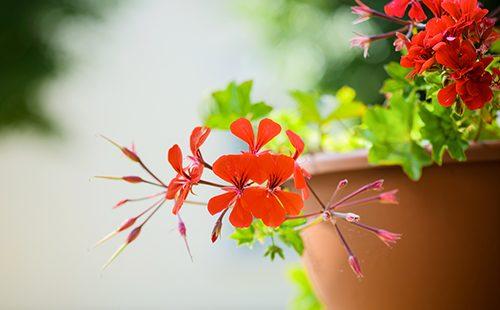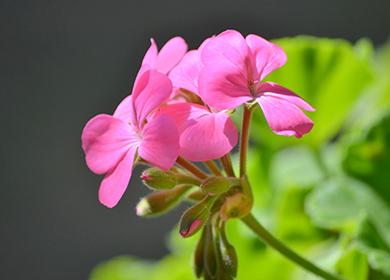The content of the article
Flexible shoots of ivy pelargonium can freely hang from a hanging planter or braid the proposed supports. The length of the lashes with good care reaches almost a meter. Lush inflorescences of various shades give a special decorative effect to ampel culture.
Plant description
Evergreen shrub geranium with long creeping shoots. It is actively grown in apartments as an ampelous culture, in the southern regions it is planted in open ground for vertical and horizontal gardening. The natural environment for the growth of ivy pelargonium is South Africa. The name is due to the leaf form, which is uncharacteristic for pelargonium - they resemble ivy foliage.
Shoots are very long, curly, flexible. Leaves are soft, with a smooth glossy surface. The ivy pelargonium has gained popularity among gardeners with an unusual leaf shape and long flowering. The plant is quite hardy - from April to October it can be kept on the balcony.
Blossoms in simple or double flowers, collected in umbellate inflorescences. There are many hybrid varieties with a variety of colors. There are specimens with pink, purple, raspberry, white, orange and multi-colored flowers. Flowering occurs in the spring-summer period. Therefore, autumn needs special care for the flower.
Pelargonium Pelargonium Care: What to Consider
As a result of many years of breeding, about 75 different varieties of ivy pelargonium were bred. Among them, there are varieties with simple or double flowers of different colors. The content of all varieties is approximately the same. How to care for ivy pelargonium in a pot of caterpillars and various insects?
- Lighting. Very fond of bright light and sun. She is not afraid of the open sun, she needs to shade only in the hottest days. The duration and intensity of flowering of the ivy pelargonium depends on the duration of daylight hours. The need for light does not decrease even in winter - you have to organize additional artificial lighting.
- Temperature. The optimum temperature for maintenance in the summer is about 20-25 ° C. The heat withstands the condition of enhanced irrigation. In summer, she feels good on the balcony. In winter, the temperature is maintained at 15 ° C. It does not tolerate a further decrease in temperature - it starts to hurt, is inhibited in growth.
- Air humidity. It treats dry air neutrally, does not require artificial humidification. Spraying of the ivy pelargonium is contraindicated. Moisture on the leaves leads to a loss of decorativeness, decay.
- Watering. In warm time, they often water it, but they do not allow stagnation of moisture - they definitely make good drainage.Watering only after drying of the upper layer of the substrate. Closer to wintering, the frequency of watering is reduced. In winter, occasionally watered, not more than twice a month to maintain light soil moisture.
- The soil. Land for planting needs fertile. The composition of the soil includes humus, peat, turf and necessarily sand. It is useful to add some ash, perlite and charcoal.
- Transfer. Transplanted annually or every two years. The best time for transplanting is in the early spring, before the start of active growth and flowering. Pots are not too spacious. Between the walls of the pot and the roots there should be a space of not more than 2 cm.
- Top dressing. They feed weekly - they use mainly mineral fertilizers. High nitrogen preparations are introduced in very limited quantities. Sometimes you can feed organic matter, but it is not recommended to get involved in it.
Pruning
The formation of pelvic pelargonium consists in the timely conduct of pruning and pinching. This is a necessary measure to maintain the decorativeness of ampelous culture and stimulate flowering. How to prune ivy pelargonium?
The main pruning is in the fall. The shoots are pruned heavily - they leave seven leaves. Basal shoots are not touched, only axillary shoots are cut off. Dried and bare stems are also removed.
If during wintering, pelargonium has managed to grow, it is cut again. Further, throughout the growing season, wilted inflorescences, dried leaves are sheared, thinning bushes.
Breeding methods
The most commonly used propagation of pelargonium is the condyle by cuttings. Less commonly propagated through sowing seeds. The advantage of the first method is the complete preservation of all the characteristics of the variety of the mother plant.
Cuttings
Description. Pelargonium peliconium can be cut from March to the end of summer. The tops of shoots are used as cuttings. The best option is pruning after flowering, combined with cuttings. Root pelargonium can be planted only directly in the ground. Attempts to root in water lead to rotting of the cuttings.
Procedure
- Select cuttings up to 12 cm.
- The lower leaves are removed, the slice is treated with carbon powder and dried for at least six hours in a shaded, well-ventilated place.
- Loose soil with obligatory addition of sand is taken as a substrate. Cuttings are deepened by a few centimeters with a slight slope.
- The soil is sprayed from the spray gun, subsequently moistened as it dries.
- They are kept in a bright, warm place until rooting. They are not in a hurry with transplantation - they are waiting for the full development of the root system.
Seeds
Description. Only fresh pelargonium seeds sprout quickly. When buying, be sure to pay attention to the date of packaging. It is possible to plant seeds collected with one's own hand, but the result may turn out to be unexpected - varietal characters will not be preserved. Sowing begins in the winter. You can use any light, nutritious soil, adding crushed sphagnum to it.
Procedure
- A flat, wide container is filled with a substrate, the surface is moistened from a fine atomizer.
- Seeds close up to a depth of 1 cm.
- It is better to germinate under glass to maintain stable soil moisture and uniform temperature.
- Shelter is removed daily to ventilate the greenhouse and remove excess condensate.
- Keep warm - at least 22 ° C. Provide a long daylight hours of about 12 hours. In such conditions, the sprouts will appear after 10 days. In another month they can be planted in separate containers.
Common Diseases
Like most hybrids, ivy pelargonium is susceptible to disease. The most common diseases, their symptoms and treatment are described in the table.
Table - Diseases of the ivy pelargonium
| Disease name | Characteristic manifestations | Treatment methods |
|---|---|---|
| Flower mold | The appearance of mold on flowers | - Timely removal of wilted peduncles; - treatment with drugs "Fundazol" or "Fitosporin-M" |
| Swelling of the leaves (edema) | - Deformation of the leaves; - the formation of growths on the leaves | - Cutting deformed leaves; - reduction of watering |
| Leaf spotting | - The appearance of spots; - growth inhibition | - Use of fungicides; - decrease in air humidity |
| Pelargonium rust | - Brownish-red spots; - falling of leaves; - pelargonium does not bloom | - Removal of affected leaves; - treatment with systemic fungicide; - isolation from healthy plants |
| Curly virus | - Pale yellowish spots; - curly leaves | - Pruning slightly affected plants, followed by fungicide treatment; - destruction of severely affected plants |
| Blackleg | - Blackening of the root part of the stem; - weakening, death of the plant | Rooting healthy cuttings to replace a diseased flower |
| Gray rot | - Brown spots; - fluffy gray coating; - leaf spotting | Processing means "Vitaros", "Fundazol" |
| Alternariosis | - Brownish spots with a bright middle; - fluffy coating; - lack of flowering; - yellowing and drying of leaves | Spraying and watering with preparations "Ridomil Gold", "Skor" |
| Rhizoctonia rot | - Dark spots appear on the stems; - lack of flowering; - lethargy, yellowing of leaves | - Cessation of watering; - spraying with solutions "Rovral", "Vitaros", "Fundazol" |

Common pests
Pests are a fairly common problem of cultural pelargonium. The provoking factors of their appearance are too high or low humidity, excessive watering, and proximity to infected plants. The main pests of ivy pelargonium and methods for controlling them are described in the table.
Table - Pests of ivy pelargonium
| Insect name | Characteristic signs | Ways to fight |
|---|---|---|
| Multi-claw ticks | Brown scab on the underside of leaves | - Treatment with soapy water; - treatment with fungicides "Kemifos", "Antikleshch", "Jet" |
| Spider mites | - The leaves turn yellow; - the appearance of yellow specks; - braiding with a thin cobweb | - Treatment of affected areas with mineral oil; - spraying with insecticides "Akarin", "Vermitek" |
| Mushroom mosquitoes (larvae) | Rotting of the base of cuttings, seedlings | Young plants are prophylactically treated with the preparations “Thunder-2”, “Aktara”, “Flies” |
| Thrips | - The appearance of cork growths; - deformation of the growth point; - silver coating; - spots and holes on the petals | Repeated use of insecticides "Alatar", "Tsvetolux" |
| Aphid | - Adhesive coating; - twisting the tops of the shoots | - Washing with soapy water; - treatment with insecticides or infusion of tobacco dust |
| Caterpillars | - Gnawing on the leaves; - black stool of caterpillars | Insecticide treatment "Zolon", "Fitoverm" |
| Whitefly | - White butterflies; - pale yellow larvae; - yellowing of the leaves; - sticky discharge | - Use of traps for adult insects; - the use of insecticides "Aktara", "Inta-vir" |
Since it is quite difficult to take care of the pelvic pelargonium, beginners are encouraged to begin experiments in growing flowers with more unpretentious, disease-resistant plants. The ivy pelargonium retains decorativeness and blooms profusely only in favorable conditions.

